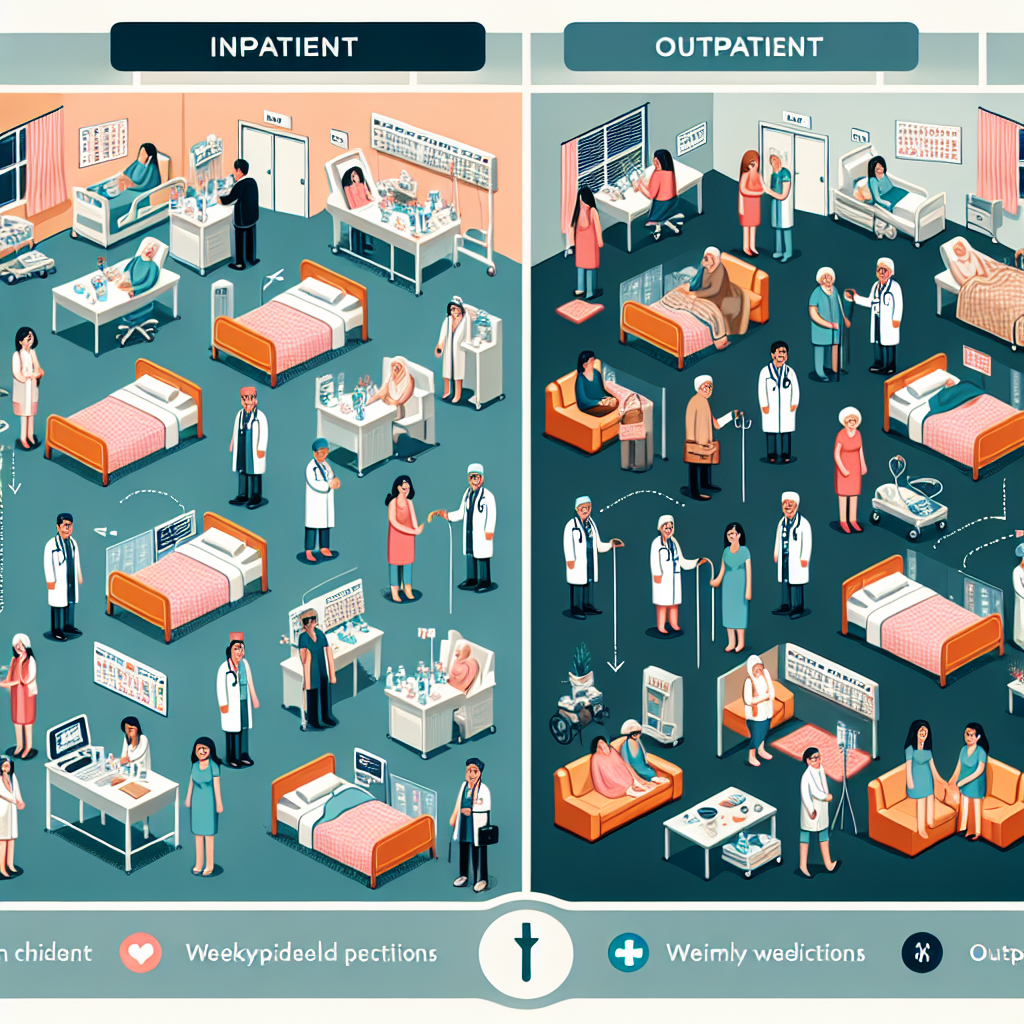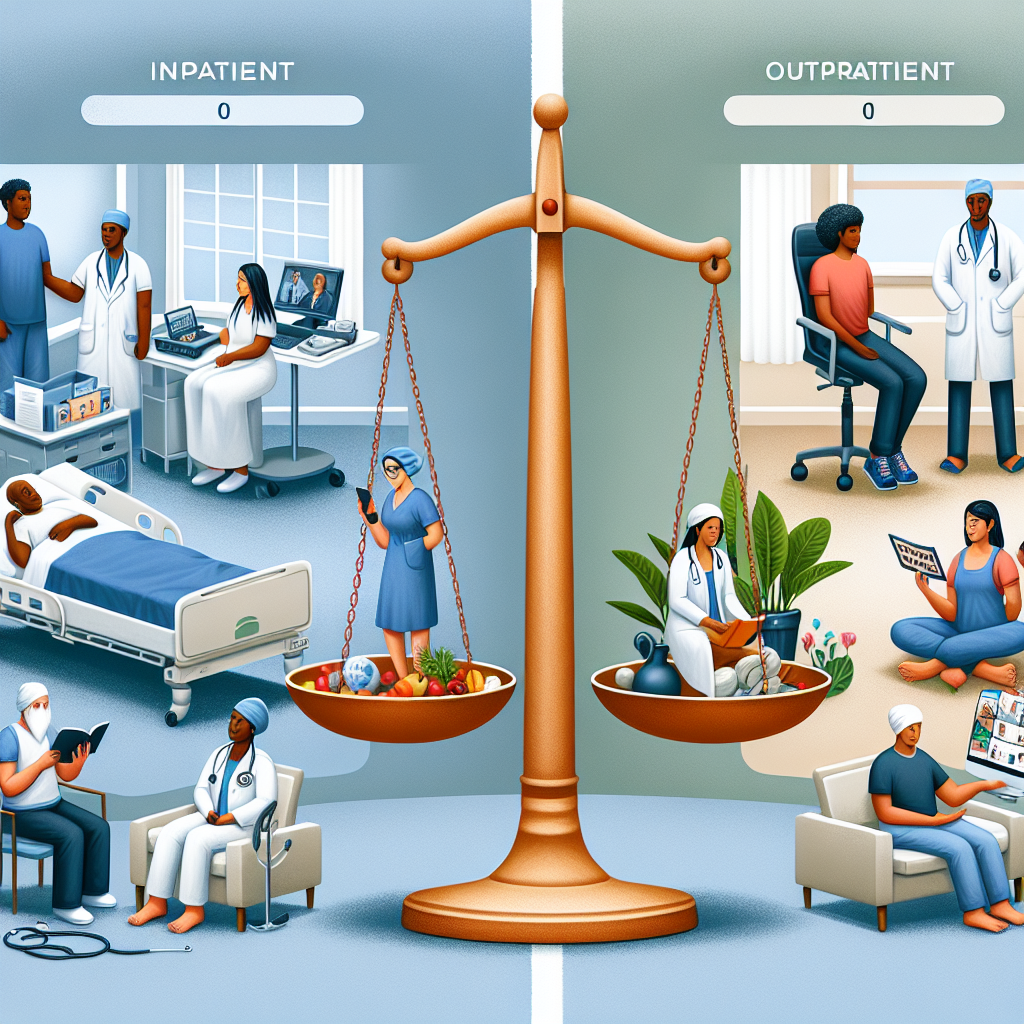-
Table of Contents

“Choosing the Right Path: Inpatient vs. Outpatient Treatment for Your Recovery Journey”
Introduction
When facing the challenge of seeking treatment for a medical or psychological condition, one of the critical decisions involves choosing between inpatient and outpatient care. Both options offer distinct advantages and cater to different needs, making it essential to understand their differences to determine which is right for you. Inpatient treatment involves staying at a facility for a designated period, providing intensive, round-the-clock care and support. This option is often ideal for individuals requiring close monitoring, immediate access to medical professionals, and a structured environment to facilitate recovery. On the other hand, outpatient treatment allows patients to live at home while attending scheduled therapy sessions or medical appointments. This flexibility can be beneficial for those with less severe conditions, strong support systems, or commitments that make full-time residency impractical. By examining the benefits and limitations of each approach, you can make an informed decision that aligns with your specific health needs and lifestyle.
Inpatient vs. Outpatient Treatment: Key Differences and Benefits
When considering treatment options for various health conditions, understanding the key differences and benefits of inpatient versus outpatient treatment is crucial. Both approaches offer unique advantages, and the choice between them often depends on the specific needs and circumstances of the individual. By exploring these differences and benefits, you can make a more informed decision about which treatment path may be right for you.
Inpatient treatment, also known as residential treatment, involves staying at a facility for a designated period. This type of treatment is often recommended for individuals who require intensive care and constant supervision. One of the primary benefits of inpatient treatment is the structured environment it provides. Patients have access to medical professionals around the clock, ensuring that any complications or emergencies are promptly addressed. This level of care can be particularly beneficial for those dealing with severe conditions, such as substance abuse, mental health disorders, or chronic illnesses that require close monitoring.
Moreover, inpatient treatment offers a comprehensive approach to recovery. Patients can participate in various therapies, including individual counseling, group therapy, and holistic treatments like yoga or art therapy. This multifaceted approach helps address the root causes of the condition and promotes overall well-being. Additionally, being in a controlled environment minimizes distractions and temptations, allowing patients to focus entirely on their recovery journey.
On the other hand, outpatient treatment provides a more flexible option for those who do not require constant supervision. This type of treatment allows individuals to live at home and continue with their daily responsibilities while attending scheduled therapy sessions or medical appointments. One of the significant benefits of outpatient treatment is its adaptability. It can be tailored to fit the patient’s schedule, making it easier to balance work, family, and other commitments.
Outpatient treatment is often suitable for individuals with less severe conditions or those who have already completed an inpatient program and are transitioning back to everyday life. It offers continuity of care, ensuring that patients continue to receive support and guidance as they reintegrate into their routines. Furthermore, outpatient treatment can be more cost-effective than inpatient care, making it an attractive option for those with financial constraints.
Despite the differences between inpatient and outpatient treatment, both share the common goal of helping individuals achieve and maintain recovery. The choice between the two ultimately depends on various factors, including the severity of the condition, the level of support needed, and personal preferences. It is essential to consult with healthcare professionals to determine the most appropriate treatment plan based on individual needs.
In making this decision, it is also important to consider the long-term benefits of each approach. Inpatient treatment may provide a solid foundation for recovery, offering intensive support and a structured environment that can lead to significant progress in a relatively short period. Conversely, outpatient treatment can offer sustained support over a longer duration, helping individuals develop coping strategies and resilience as they navigate their daily lives.
Ultimately, the journey to recovery is deeply personal, and there is no one-size-fits-all solution. Whether you choose inpatient or outpatient treatment, the most important thing is to take that first step towards seeking help. Embrace the process with an open mind and a willingness to commit to your well-being. With the right support and determination, you can overcome the challenges and move towards a healthier, more fulfilling life.
Choosing Between Inpatient and Outpatient Treatment: Factors to Consider
Choosing between inpatient and outpatient treatment is a significant decision that can profoundly impact your journey toward recovery. Understanding the differences and evaluating the factors that influence this choice can help you make an informed decision that aligns with your needs and circumstances. Both treatment options offer unique benefits and challenges, and the right choice depends on various personal and situational factors.
Inpatient treatment, also known as residential treatment, involves staying at a facility for a designated period, typically ranging from 30 to 90 days or longer. This immersive environment provides a structured and supportive setting, which can be particularly beneficial for individuals with severe addictions or co-occurring mental health disorders. The round-the-clock care and supervision ensure that patients receive immediate assistance and support, reducing the risk of relapse during the critical early stages of recovery. Moreover, the comprehensive nature of inpatient programs often includes a combination of medical care, therapy, and holistic treatments, fostering a well-rounded approach to healing.
On the other hand, outpatient treatment allows individuals to live at home while attending scheduled treatment sessions at a facility. This flexibility can be advantageous for those who have work, school, or family commitments that they cannot abandon. Outpatient programs vary in intensity, from partial hospitalization programs (PHPs) that require several hours of treatment each day to less intensive options like standard outpatient programs (OPs) that meet a few times a week. This adaptability makes outpatient treatment a viable option for individuals with milder addictions or those who have already completed an inpatient program and are transitioning back to everyday life.
When deciding between inpatient and outpatient treatment, one crucial factor to consider is the severity of the addiction. Inpatient treatment is often recommended for individuals with long-standing or severe substance use disorders, as the controlled environment minimizes exposure to triggers and temptations. Conversely, outpatient treatment may be suitable for those with less severe addictions or those who have a strong support system at home.
Another important consideration is the presence of co-occurring mental health disorders. Inpatient facilities are typically better equipped to handle dual diagnoses, offering integrated treatment plans that address both substance use and mental health issues simultaneously. This comprehensive approach can be vital for individuals whose mental health conditions exacerbate their addiction.
Financial considerations also play a significant role in the decision-making process. Inpatient treatment tends to be more expensive due to the cost of housing, meals, and round-the-clock care. However, many insurance plans cover a portion of these costs, and some facilities offer sliding scale fees based on income. Outpatient treatment is generally more affordable, making it a more accessible option for those with financial constraints.
Support systems are another critical factor. Individuals with a strong network of family and friends who can provide encouragement and accountability may find outpatient treatment more feasible. In contrast, those lacking such support might benefit more from the community and camaraderie found in an inpatient setting.
Ultimately, the choice between inpatient and outpatient treatment is deeply personal and should be made in consultation with healthcare professionals who can assess your specific needs and circumstances. Both paths offer the potential for recovery, and the most important step is committing to the journey. By carefully considering the severity of your addiction, the presence of co-occurring disorders, financial implications, and available support systems, you can make a decision that sets you on the path to a healthier, more fulfilling life.
Q&A
1. **Question:** What are the primary differences between inpatient and outpatient treatment?
**Answer:** Inpatient treatment involves staying at a facility 24/7 for a period of time, providing intensive care and supervision, while outpatient treatment allows individuals to live at home and attend scheduled treatment sessions, offering more flexibility and less intensive care.
2. **Question:** What factors should be considered when choosing between inpatient and outpatient treatment?
**Answer:** Factors to consider include the severity of the condition, the need for medical supervision, personal responsibilities (such as work or family), support system availability, and financial considerations.
Conclusion
In conclusion, the choice between inpatient and outpatient treatment depends on the severity of the condition, the level of support needed, and personal circumstances. Inpatient treatment offers intensive, round-the-clock care and is suitable for severe cases requiring constant supervision. Outpatient treatment provides flexibility, allowing individuals to maintain daily responsibilities while receiving care, making it ideal for those with milder conditions or strong support systems. Consulting with healthcare professionals can help determine the most appropriate option based on individual needs and treatment goals.



